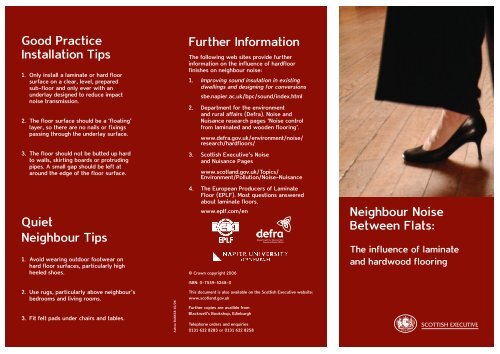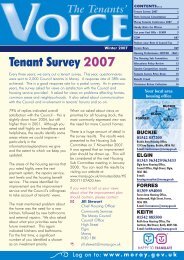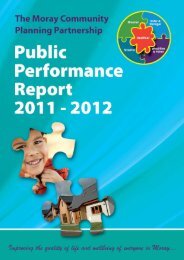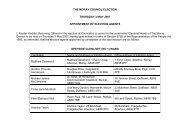Neighbour Noise Between Flats: The Influence of Laminate and ...
Neighbour Noise Between Flats: The Influence of Laminate and ...
Neighbour Noise Between Flats: The Influence of Laminate and ...
Create successful ePaper yourself
Turn your PDF publications into a flip-book with our unique Google optimized e-Paper software.
Good Practice<br />
Installation Tips<br />
1. Only install a laminate or hard floor<br />
surface on a clear, level, prepared<br />
sub-floor <strong>and</strong> only ever with an<br />
underlay designed to reduce impact<br />
noise transmission.<br />
2. <strong>The</strong> floor surface should be a ‘floating’<br />
layer, so there are no nails or fixings<br />
passing through the underlay surface.<br />
3. <strong>The</strong> floor should not be butted up hard<br />
to walls, skirting boards or protruding<br />
pipes. A small gap should be left at<br />
around the edge <strong>of</strong> the floor surface.<br />
Quiet<br />
<strong>Neighbour</strong> Tips<br />
1. Avoid wearing outdoor footwear on<br />
hard floor surfaces, particularly high<br />
heeled shoes.<br />
Further Information<br />
<strong>The</strong> following web sites provide further<br />
information on the influence <strong>of</strong> hardfloor<br />
finishes on neighbour noise:<br />
1. Improving sound insulation in existing<br />
dwellings <strong>and</strong> designing for conversions<br />
sbe.napier.ac.uk/bpc/sound/index.html<br />
2. Department for the environment<br />
<strong>and</strong> rural affairs (Defra). <strong>Noise</strong> <strong>and</strong><br />
Nuisance research pages ‘<strong>Noise</strong> control<br />
from laminated <strong>and</strong> wooden flooring’.<br />
www.defra.gov.uk/environment/noise/<br />
research/hardfloors/<br />
3. Scottish Executive’s <strong>Noise</strong><br />
<strong>and</strong> Nuisance Pages<br />
www.scotl<strong>and</strong>.gov.uk/Topics/<br />
Environment/Pollution/<strong>Noise</strong>-Nuisance<br />
4. <strong>The</strong> European Producers <strong>of</strong> <strong>Laminate</strong><br />
Floor (EPLF). Most questions answered<br />
about laminate floors.<br />
www.eplf.com/en<br />
© Crown copyright 2006<br />
<strong>Neighbour</strong> <strong>Noise</strong><br />
<strong>Between</strong> <strong>Flats</strong>:<br />
<strong>The</strong> influence <strong>of</strong> laminate<br />
<strong>and</strong> hardwood flooring<br />
2. Use rugs, particularly above neighbour’s<br />
bedrooms <strong>and</strong> living rooms.<br />
3. Fit felt pads under chairs <strong>and</strong> tables.<br />
Astron B48658 10/06<br />
ISBN: 0-7559-5248-0<br />
This document is also available on the Scottish Executive website:<br />
www.scotl<strong>and</strong>.gov.uk<br />
Further copies are availble from<br />
Blackwell’s Bookshop, Edinburgh<br />
Telephone orders <strong>and</strong> enquiries<br />
0131 622 8283 or 0131 622 8258
What noise<br />
<strong>The</strong> laying <strong>of</strong> a laminate or hardwood floor in place<br />
<strong>of</strong> carpet results in more impact noise (footsteps,<br />
chair scrape, dropped items) travelling into the floor.<br />
<strong>The</strong>se noises can quickly become an annoyance<br />
for downstairs neighbours, <strong>of</strong>ten without the upper<br />
property being aware <strong>of</strong> it.<br />
Who is at Risk<br />
<strong>Laminate</strong> <strong>and</strong> hardwood flooring is an attractive<br />
alternative to carpet but is not recommended for<br />
every type <strong>of</strong> building. Residential flats are generally<br />
designed to take carpeted floors; hard timber floor<br />
finishes are not normally suitable in these buildings<br />
because <strong>of</strong> their susceptibility to impact noise<br />
transmission. <strong>Flats</strong> affected by impact noise problems<br />
can also suffer from more general issues <strong>of</strong> poor<br />
sound insulation i.e. hearing noise from neighbouring<br />
properties such as voices, TV, stereo etc.<br />
Before removing s<strong>of</strong>t floor coverings, it is recommended<br />
that you speak to your downstairs neighbour about the<br />
existing level <strong>of</strong> sound insulation between properties in<br />
order to identify if the sound insulation is good enough to<br />
allow the use <strong>of</strong> a hard floor surface. If the sound insulation<br />
between flats is described as only ‘Satisfactory’ or worse,<br />
it is recommended against either revealing floorboards<br />
or installing timber laminate or hardwood floor surfaces<br />
within an upper floor flat.<br />
It is generally only specially designed flats with substantial<br />
floor structures that are able to feature hard floor surfaces<br />
without causing adverse neighbour reaction.<br />
What can be done<br />
New laminate <strong>and</strong> hardwood floors should always be laid<br />
on an underlay. This extra layer helps level the sub-floor,<br />
prevents the joints from cracking <strong>and</strong> helps extend the life<br />
<strong>of</strong> the floor. <strong>The</strong>ir use also helps reduce the amount <strong>of</strong><br />
impact noise passed through the floor, although underlays<br />
do not prevent all noise <strong>and</strong> are considerably less effective<br />
than carpets at reducing neighbour footstep noise.<br />
Advice on appropriate underlays, specially designed<br />
to reduce impact noise transmission, can be obtained<br />
from the flooring manufacturers.<br />
Legal Considerations<br />
Prior to the purchase <strong>and</strong> installation <strong>of</strong> new laminate<br />
or hardwood flooring in an upper floor flat confirmation<br />
should be made that there are no tenancy or deed<br />
conditions forbidding their use.<br />
If you live in a lower flat <strong>and</strong> are affected by neighbour<br />
noise there are limited options to address the problem.<br />
Whilst a legal option can be tried, progress is only likely<br />
to be achieved where the root issue can be attributed<br />
to structural alteration <strong>of</strong> the floor or unreasonable<br />
behaviour by the residents. Further advice on dealing<br />
with noise problems <strong>and</strong> accessing mediation services<br />
is available from the Local Authority’s Environmental<br />
Health Department.<br />
<strong>Neighbour</strong> noise complaints caused by hard floor surfaces have increased sharply over recent years. Problems arise when carpets <strong>and</strong> underlays are replaced<br />
by hard floor surfaces <strong>and</strong> previously muffled sounds <strong>of</strong> footsteps, chair scrapes <strong>and</strong> dropped items become distinct <strong>and</strong> intrusive for downstairs neighbours.

















